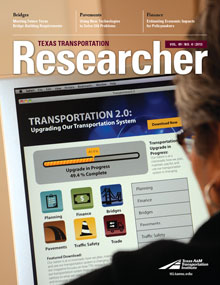TRENDS and TREDIS Provide Cost-Benefit Analysis and Revenue Forecasting
Evaluating transportation improvement alternatives in a cost-effective way is essential to choosing the best solution. That’s where modeling comes in. The more realistic the model and the more accurate the data, the better informed policymakers are when deciding which solution to pursue.

To that end, TTI researchers are using two advanced models — the Transportation Revenue Estimator and Needs Determination System (TRENDS), developed by TTI, and the Transportation Economic Development Impact System (TREDIS), a product of EDR Group, Inc. — on a project entitled Economic Impact Analysis and Revenue Project Modeling. Under the auspices of the newly created Policy Research Center (PRC), this study will forecast revenues generated under different scenarios using TRENDS and determine the benefits received from a transportation project using TREDIS.
“TRENDS is designed to provide transportation planners, policymakers and the public with a tool to forecast revenues and expenses for TxDOT [the Texas Department of Transportation] through 2040,” explains Brianne Glover, TTI assistant research scientist. “It forecasts revenues, expenditures and fund balances for each year studied.”
Updated monthly, TRENDS allows the user to see the revenue projection of a funding scenario using input variables like population forecasts, inflation rates and fuel efficiency. Arguably, TRENDS‘ most powerful feature is a local option sub-model for each of Texas’ 25 metropolitan planning organizations (MPOs). This allows MPOs to analyze changes in local revenues by creating or adjusting local fees or fuel efficiency rates so the results generated for their areas are more realistic.
“In the current project, for example, we’re expanding TRENDS to add the capability to estimate how alternative fuel vehicles could impact the state’s fuel tax revenues,” explains Glover. “That result could, in turn, impact transportation funding since the state fuel tax is currently the principal financing method. Knowing how big that impact could be can help guide what funding alternatives policymakers pursue.”
Researchers are also using TREDIS, which uses travel patterns, market access and spending data to estimate costs, benefits and economic impacts for a scenario. Using TREDIS, transportation planners can assess the impact of various economic development initiatives and conduct cost-benefit analyses for transportation investments across multiple modes of transportation (e.g., highway, bus, rail, aviation, marine and multimodal projects).
“TREDIS is great for giving a more holistic assessment of public and private investment funds,” says Glover. “An improvement at a port could change the modes used to transport goods to and from that port, for example. Being able to look at transport alternatives using multiple modes is a powerful way to determine how one small change in the mode we choose to move goods can have a ripple effect across the local economy.”
In the current PRC project, Glover and her team are using TREDIS to conduct economic-impact studies for various policy options. As they evaluate planning alternatives, researchers are studying the resulting regional impacts such as changes in business output, increased jobs and increased wage income, for each option.
“Applying the results of these models at the regional level gives us real-world estimates of how changes would impact our citizens without the expense of actually changing the variables involved,” says Maureen McCoy, director of Austin’s Capital Area Metropolitan Planning Organization. “No pun intended, but it’s hard to overestimate the value of that to our regional planning process.”

